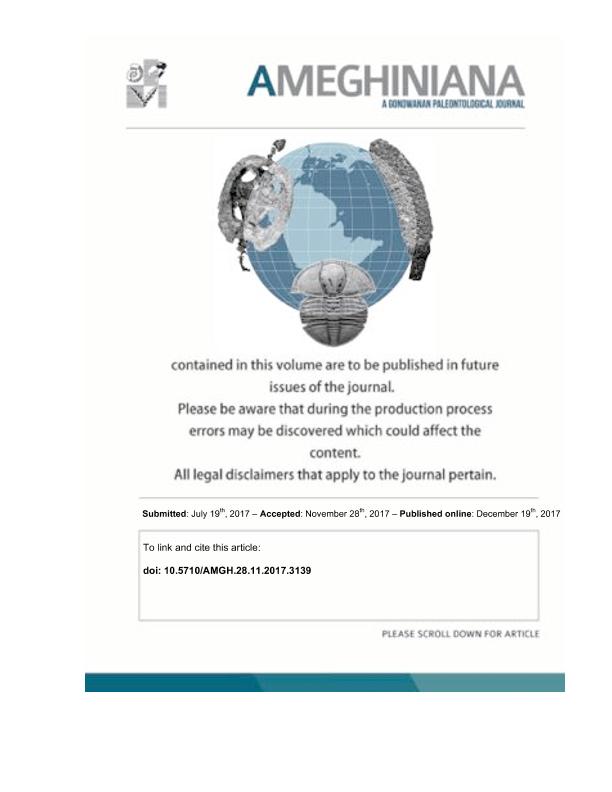Artículo
A partir del análisis de una serie de atributos tafonómicos sobre ejemplares de Heleobia parchappii provenientes de secuencias fluviales y paleolacustres holocenas acumuladas en la cuenca baja del río Salado, se ha realizado un estudio comparativo de la alteración superficial de sus conchas para evaluar si existen diferencias entre ambos ambientes. Los resultados principales permiten, a partir de un escalonamiento multidimensional no métrico (NMDS) y test de análisis de similaridad (ANOSIM) (R=0,31, p<0,01), reconocer y diferenciar estadísticamente los dos grupos de muestras, presentando aquellas recuperadas del ambiente paleolacustre características tafonómicas más similares entre sí, mientras las fluviales muestran mayor dispersión. El análisis de porcentaje de similaridad (SIMPER) permitió determinar que las variables descoloración y disolución fueron las más importantes para diferenciar ambos grupos, y los valores de los índices obtenidos (Grados Tafonómicos Totales) siempre fueron más altos en los ensambles paleolacustres evidenciando un deterioro mayor en ellos. Las diferencias encontradas en la preservación podrían explicarse por el tiempo de permanencia de los restos cerca de la interfaz agua-sedimento y las diferencias en la tasa de sedimentación en ambos ambientes. Estas diferencias estarían relacionadas con cambios en el régimen hidrológico (fluctuaciones en los niveles de agua superficial y subterránea) que, si bien afectan toda el área de estudio, son más intensos y frecuentes en las lagunas favoreciendo la descomposición de las conchillas acumuladas en este ambiente. From the analysis of the taphonomic attributes of the specimens of Heleobia parchappii found in fluvial and paleolacustrine sequences of the lower basin of the Salado River, the surface alteration of their shells was comparatively studied in order to assess the differences between both environments. The main results that were obtained by means of Non-Metric Multidimensional Scaling (NMDS) and analysis of similarity (ANOSIM) tests (R=0.31, p<0.01) enabled the recognition and statistical differentiation of both groups of samples. The taphonomic characteristics presented by those that were recovered from the paleolacustrine environment are more similar to each other, whereas those from the fluvial environment showed greater dispersion. Through the similarity percentage (SIMPER) analysis we could determine that the variables of discoloration and dissolution were the most important features to differentiate both groups, and that the values of the indexes (Total Taphonomic Grades) were always higher in the paleolacustrine assemblages, thus showing greater decay. The differences of preservation could be explained by the residence time of the remains near the water-sediment interface as well as by the differences in the sedimentation rate in both environments, which control the different exposure cycles of the shells. These differences would be related to changes in the hydrological regime (fluctuations in surface and groundwater levels) that, although affecting the entire study area, are more intense and frequent in shallow lakes, therefore favoring the decay of the shells accumulated in this environment.
Comparative Taphonomy of Mollusk Assemblages in Quaternary Freshwater Sequences from the Salado River Basin, Buenos Aires
Fecha de publicación:
05/2018
Editorial:
Asociacion Paleontologica Argentina
Revista:
Ameghiniana
ISSN:
0002-7014
e-ISSN:
1851-8044
Idioma:
Inglés
Tipo de recurso:
Artículo publicado
Clasificación temática:
Resumen
Archivos asociados
Licencia
Identificadores
Colecciones
Articulos(CCT - LA PLATA)
Articulos de CTRO.CIENTIFICO TECNOL.CONICET - LA PLATA
Articulos de CTRO.CIENTIFICO TECNOL.CONICET - LA PLATA
Citación
Pisano, Maria Florencia; Pommarés, Nicole Nadín; Luengo, Mariel Samanta; Fucks, Enrique Eduardo; Comparative Taphonomy of Mollusk Assemblages in Quaternary Freshwater Sequences from the Salado River Basin, Buenos Aires; Asociacion Paleontologica Argentina; Ameghiniana; 55; 2; 5-2018; 197-209
Compartir
Altmétricas




